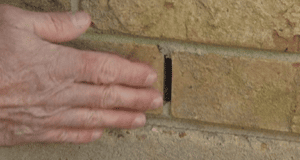
Brick houses are beautiful and no two ever look the same. They have an aesthetic look about them, are durable, and weather storms well. On a brick house, you will see weep holes throughout.
A weep hole sounds like something that makes you cry, but the good news is that it isn’t! It is actually a hole that is in brick and masonry, as well as some windows, and allows accumulated water to drain and provides ventilation. It is a good thing!
Let’s learn about what a weep hole is for windows and brick, why they are important, how they are made, and how to maintain them.
A Weep Hole
Weep holes are holes in the bottom of the brick between the brick veneer and the wood framing to let the excess rainwater flow out. The hole is about 4 5/8 inches and stops where the exterior sheathing meets the wall studs and located at the bottom of the siding. There are also weep holes you will see in some window tracks.
Windows and Weep Holes
Many windows have weep holes as they need to have an area for the water to drain so it does not come into the home. If the water does not drain, it will go sit on the wooden window sill and cause it to rot.
Sometimes painters won’t see the weep hole or ignore that it is there and paint over it or use caulk. Be sure to let them know not to do that so the hole can do its job!
Flashing Near Windows
Flashing is always near the windows and doors to keep the water and moisture out. Sometimes, depending on codes in housing communities, you may or may not see weep holes near windows and doors.
However, some masons will add them in, even if housing codes don’t require them. Check out the video below about weep holes in windows and how to maintain them.
Brick Weep Holes and Why Weep Holes Are Important

We learned that weep holes in windows are important and they are important in bricks as well. When you are shopping for a brick home or building one, you need to make sure they are visible on the brick. Bricks are porous and soak up the rainwater and the water can go through the brick and down the backside.
If there is no weep hole, the water has nowhere to go- except inside the wall. You don’t want that to happen. The weep hole allows the water to drain out of the house and not cause this issue to happen. Take a look at the video below about why weep holes are important in brick buildings.
The weep hole allows air to flow through the external and internal walls for ventilation. If it doesn’t flow through, then condensation and mildew will form. Thus lowering the expected life of the studs in the wall and other materials that were used in the building of the home.
How Weep Holes Are Made and Flashing
When building a brick house, the mason creates these holes 33 inches apart from each other in the layers of brick in various ways:
1. Using a hollow tube- this tube is put in the mortar joint (looks like cement) and then the mortar is placed on top of it. Then, when the hollow tube is removed, the weep hole is left.
2. Oiled rope – an object like an oiled rope is another idea as it can lay in the mortar. Then, as the mortar starts to harden, the rope can easily be pulled out.
Flashing Helps the Weep Hole
As mentioned above, the purpose of the weep hole is to let the runoff escape the home. Flashing is usually made of metal and is put above the bottom layer of bricks for any excess water that doesn’t make it outside on its own.
Maintenance of Weep Holes in Brick
Don’t Seal Weep Holes
Some homeowners will also see these holes and decide they want to seal them to keep out pests and rodents. However, this is not a good idea. Once you seal the weep hole, it cannot do its job and the moisture and water can’t escape.

Use a Cover for a Weep Hole
Instead, you can use a cover that will allow the air and water to escape, but keep the pests out. Another idea is to use a screen. This will continue to allow the weep hole to do its job and keep the water where it should go.
Keep Vegetation Away from the Home
When building a new house, the builders provide vegetation for the home. However, sometimes vegetation is too close to the house and will cause blocking of the hole or invite unwanted pests. A good rule of thumb is vegetation about 18 inches away from the home.
Conclusion
Weep holes are essential to allowing the rainwater to run off the house. If the water stays in the bricks, it seeps into the interior walls. They are also good to have in certain types of windows. If you have questions about weep holes or issues with pests in the weep holes, leave us a note below!



